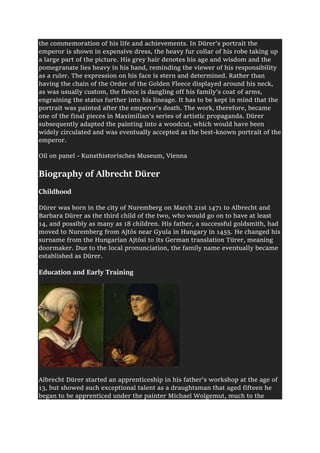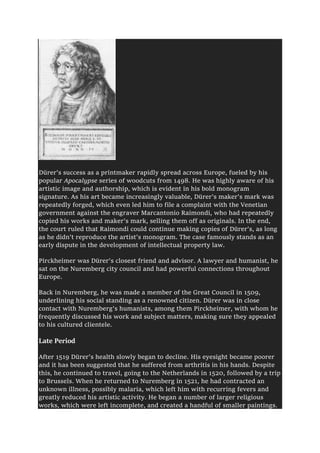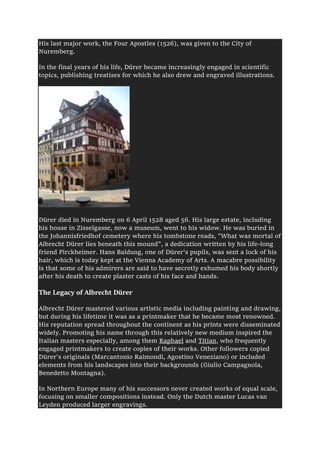Albrecht Dürer was a famous 15th-16th century German artist considered one of the greatest of the Northern Renaissance. He created woodcuts, engravings, and paintings that combined detailed Northern styles with Renaissance ideals of balance and proportion. Some of his most renowned works include the Apocalypse series of woodcuts, self-portraits that depicted himself as religious figures, and meticulously detailed natural studies of animals. Dürer helped establish printmaking as a fine art form and wrote influential treatises on mathematics and human proportion.
![Albrecht Dürer
Summary
Read a brief summary of this topic
Albrecht Dürer, (born May 21, 1471, Imperial Free City of Nürnberg
[Germany]—died April 6, 1528, Nürnberg), painter and printmaker generally
regarded as the greatest German Renaissance artist. His vast body of work
includes altarpieces and religious works, numerous portraits and self-portraits,
and copper engravings. His woodcuts, such as the Apocalypse series (1498),
retain a more Gothic flavour than the rest of his work.
German Renaissance Draughtsman, Engraver, Woodcutter and Painter
Albrecht Dürer
Summary of Albrecht Dürer
It's fair to say that without Albrecht Dürer, printmaking as we know it within
art history and contemporary art, would not exist. Despite living approximately
500 years ago, he remains one of the most famous and important printmakers
in art history, in particular bringing woodcuts printed in large editions into the
realm of fine art and the art history canon.
Even though Albrecht Dürer's fame was largely built on his prints and graphic
style, his financial income was secured with commissions of paintings of
religious subjects and portraits, and these works remain held in high esteem
for their draughtsmanship and use of color. He was, and remains, the most
famous artist of the Northern Renaissance who successfully integrated an
elaborately-detailed Northern style with Italian Renaissance's ideals of balance,
coherence, and monumentality.
Accomplishments
Until the 1500s, the art of Renaissance Italy (focused on proportion, perspective
and representations of 'man' in his environment) had remained almost entirely](https://image.slidesharecdn.com/albrechtdrer-230529041518-b76c1441/85/Albrecht-Durer-docx-1-320.jpg)










![Ever since its first publication in 1515, Dürer's Rhinoceros has remained one of
his most popular artworks. The woodcut shows the artist's interpretation of an
Indian Rhinoceros depicted from the side standing on a small patch of soil. The
date, the title RHINOCERUS, and Dürer's monogram signature are located
above the animal's head on the right. An inscription on the top reads in
translation: 'On 1 May 1513 [this should read 1515] was brought from India to
the great and powerful king Emanuel of Portugal at Lisbon a live animal called a
rhinoceros. His form is here represented. It has the color of a speckled tortoise
and it is covered with thick scales. It is like an elephant in size, but lower on its
legs and almost invulnerable. It has a strong sharp horn on its nose which it
sharpens on stones. The stupid animal is the elephant's deadly enemy. The
elephant is very frightened of it as, when they meet, it runs with its head down
between its front legs and gores the stomach of the elephant and throttles it, and
the elephant cannot fend it off. Because the animal is so well armed, there is
nothing that the elephant can do to it. It is also said that the rhinoceros is fast,
lively and cunning.'
The rhinoceros depicted in the work was a gift from Sultan Muzafar II of
Gujarat to the governor of Portuguese India. The latter sent it to King Manuel I
in Lisbon, who in turn gifted in to Pope Leo X in Rome. The animal was loaded
onto a ship but, after a brief stop at Marseille where it was admired by King
Francis I of France, the rhinoceros drowned when the ship sank in a storm.
Dürer never got the chance to see the animal himself. Its appearance was only
available to him through written accounts and it is no surprise that Dürer's
work does not show a realistic representation of a rhinoceros. The animal is
shown with thick plates that resemble a suit of armor. The surface is covered in
a pattern of circular marks. In addition to the horn on its nose, there is a
second horn between its shoulders. Its legs are scaly, almost like that of a
reptile.
As the first rhinoceros to arrive in Europe alive since the third century ACE, the
emergence of this almost mythical creature was seen in the context of the
Renaissance as part of a rediscovery of antiquity and roused huge interest.
Dürer's woodcut depiction of the animal became popular throughout Europe.
Choosing the woodcut technique over the more laborious and cost-intensive
copper engraving allowed for a quicker and easier reproduction.
The first version of the print from 1515 was followed by altogether eight
editions over the following three centuries. Later editions include an extended
text. The image was repeatedly included in scientific texts. It also inspired
subsequent artworks, from a panel in the west doors of Pisa Cathedral to Jean
Goujon's obelisk outside the Church of the Sepulchre in Paris (1549) and
Salvador Dalí's sculpture Rinoceronte vestido con puntillasvon (1956).
Woodcut - The National Gallery of Art, Washington DC](https://image.slidesharecdn.com/albrechtdrer-230529041518-b76c1441/85/Albrecht-Durer-docx-12-320.jpg)





